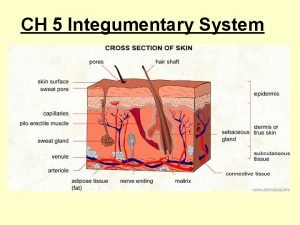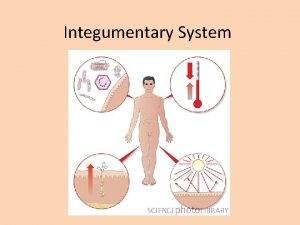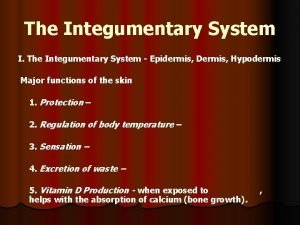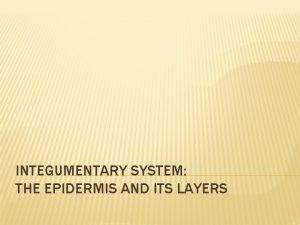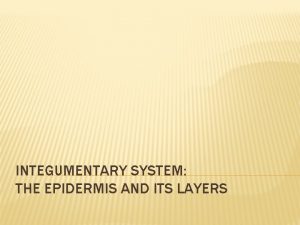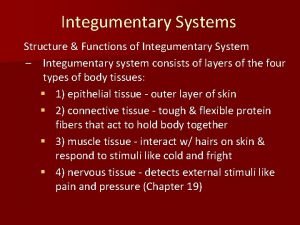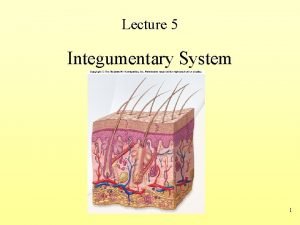Lecture Nine THE INTEGUMENTARY SYSTEM EPIDERMIS IN THE














- Slides: 14

Lecture Nine THE INTEGUMENTARY SYSTEM EPIDERMIS IN THE THICK SKIN This layer consists of five layers 1. Stratum basale or germinativum The deepest layer of the epidermis is a single layer of columnar epithelial cells. The bounds can that usually be found in this layer: A. Hemidesmosomes The bound the cells of this layer to the underlying basement membrane that attaches the epidermis to the dermis. B. Desmosomes Strongly attach these cells not only one to another but also to the overlying cells of the stratum spinosum. This layer is named stratum germinatvum because it is the main germinative layer of the epidermis where new keratin ocyte are produced. Which is characterized by mitotic activity and responsible for renewal about every (15 -30 days) depending on age, the region of the body and other factors. All cells in the stratum basale contain filaments about (10 nm) in diameter called (tonofilaments).

Lecture Nine 2. Stratum spinosum Consists of (15 -20) layers form polyhedral cells. The cytoplasm of this cell contain tonofilaments. Deep cells in this layer is mitotically active and they are together with cells of stratum basale and responsible for the turnover of the keratinocytes. The surface o these cells are covered by short cytoplasmic spines that meet with similar ones of adjacent cells to form the (intercellular bridges) and giving the prickly cell appearance. The st. germinatvum and st. spiosum are grouped together as the stratum malpighii. All mitosis occur in stratum malpighii. 3. Stratum granulosum Consist of (3 -5) layers of flattened cells whose long axis is paralled to the skin surface. The cytoplasm of these cells contains (Keratohyaline granules) these granules contain a phosphorylated histidine-rich protein as well as cytosine containing proteins. These granules are not surrounded by a membrane. Keratinocytes in the st. granulosum also keratinosomes which act as a water proof barrier.

Lecture Nine 4. Stratum lucidum More apparent in thick skin, this is translucent, thin layer of extremely flattened cells. The organelles and nuclei are no longer evidnt. These cells contain protein called (eleidin). 5. Stratum corneum It is he superficial layer of skin composed of clear, dead, scale like cells which become flattened and fused. The nucleus is absent and the cytoplasm is replaced with keratin, which derived from the tonofilament of the deeper layers of the epidermis. This is soft keratin in contrast to the hard keratin.

Lecture Nine Epidermis cells in the thick skin 1. Keratinoytes They make the major part of the epidermal cells. They are formed in the deeps layer of epidermis and undergo mitotic activity. The new cells pushed to upper. These cells found in stratum basale and stratum spinosum. The function of these cells production of keratin. 2. Langerhands cells These are star-shaped cells with numerous dendritic processes are found within the stratum spinosum. These cells contain hydrolytic enzymes. The function of these cells are in the immune response, they migrate to local lymph nodes and act as antigen-presenting cell (APC). Langerhans cells are continually replaced by cells coming from blood stream where monocytes from blood migrate into skin and differentiated into Langerhands cells.

Lecture Nine 3. Merkel cells These cells are found in stratum. Basale they have irregularly shaped and the cytoplasm contains loose bundle of tonofilaments. Function of these cells unclear but they are believed to function as mechanorecptors because it form a complex with the unmyelinated sensory nerve endings. 4. Melanocytes These cells are found scattered between keratinocytes of stratum basale and stratum sipnosum, as well as within hair and dermal connective tissue. Melanocyte are derived from neural crest cells, the cells have small branched epithelial cell, their branching enable them to make contact with all keratinocytes in the stratum basale also this branch extend into upper layers. The melanocytes contain the granules called (melanosones) the function of melanosomes it secret melanin. Melanocytes occur in all region of the body most numerous in the genital area and less on the face and trunk.

Lecture Nine

Lecture Nine Epidermis in the thin skin Stratum germinativum The layer is thinner Stratum spinosum Consists of (4 layers) Stratum granulosum Consists of only one layer Stratum lucidum This layer is absent Stratum corenum This layer much thinner

Lecture Nine

Lecture Nine Dermis or corium This layer derived from mesoderm it s composed of fibrous connective tissue which includes collageous and elastic fibers surrounded by a gel-like matrix. Network of these fibers give the dermis strength and elasticity. Dermis also contains nerve, blood vessels, lymphatic vessels and various cutaneous appendages. The dermis extends from epidermis to hypodermis. The dermis can be divided into 2 layers: 1. Papillary layer The thin layer, is composed of collagenous, reticular and elastic fiber arranged in extensive network. Macrophages and fibroblast are a most cells present in papillar layer. Generally, the papillary layer contains more cells and lesser fibers than the reticular layer. The papillary layer is so called because it constitutes the major part of the dermal papillae. The bind of dermis to the epidermis are called anchoring fibrils. 2. Reticular layer It is thicker, composed of irregular dense connective tissue (mainly type I collagen). Collagen fiber is closely packed to large bundles and thick elastic fibers. The cells are less than papillary alyer, (cells include macrophage, mast cells are less than papillary layer, (cells include macrophage, mast cells, fibroblast, lymphocytes and fat cells). There is no interface between reticular and papillary layer because these two layers are continuous with each other

Lecture Nine

Lecture Nine

Lecture Nine Hypodermis or subcutaneous layer This layer consists of loose connective tissue that binds the skin loosely to the subjacent organs. The hypodermis often contains fat cells that vary in number according to the area of the body and in size according to the nutritional status of the individual. This layer is not a part of skin functionally, the hypodermis provides support for the overlying skin and attachment to deeper tissue.

Lecture Nine Skin color The major pigment responsible to skin color are: 1. Melanin The yellowish, organ or brown pigment produced by melanocytes. 2. Hemoglobin Present in red blood cell of dermal capillaries responsible on red or bluish color to the skin depending on the relative concentration of O 2. 3. Caroten Yellowish pigment present in stratum corneum this color is most clear in palm hand sole feet. The significant of pigmentation is protection against harmful affect of sun light.

Lecture Nine Hormonal control of pigmentation 1. Melanocyte stimulating hormone (MSH) This hormone secreted from hypothesis gland. The function of this hormone increase the general pigmentation of skin by increasing melanin production. 2. Cortisol hormone (CH) This hormone produce by adrenal gland. 3. Adernocortico tropin hormone (ACTH) It is screated from hypophoysis. 4. Estrogen hormone This hormone produce by adrenal gland.
 Contains several layers of polygonal keratinocytes
Contains several layers of polygonal keratinocytes 01:640:244 lecture notes - lecture 15: plat, idah, farad
01:640:244 lecture notes - lecture 15: plat, idah, farad Cutaneous membrane
Cutaneous membrane Integumentary system vocabulary
Integumentary system vocabulary Fetal pig integumentary system
Fetal pig integumentary system Integumentary system adalah
Integumentary system adalah Epidermis layers
Epidermis layers The integumentary system exercise 7
The integumentary system exercise 7 Integumentary system abbreviations
Integumentary system abbreviations Integumentary system medical terminology
Integumentary system medical terminology The integumentary system
The integumentary system Integumentary system assessment
Integumentary system assessment Integumentary system analogy
Integumentary system analogy Cat integumentary system
Cat integumentary system The integumentary system
The integumentary system










